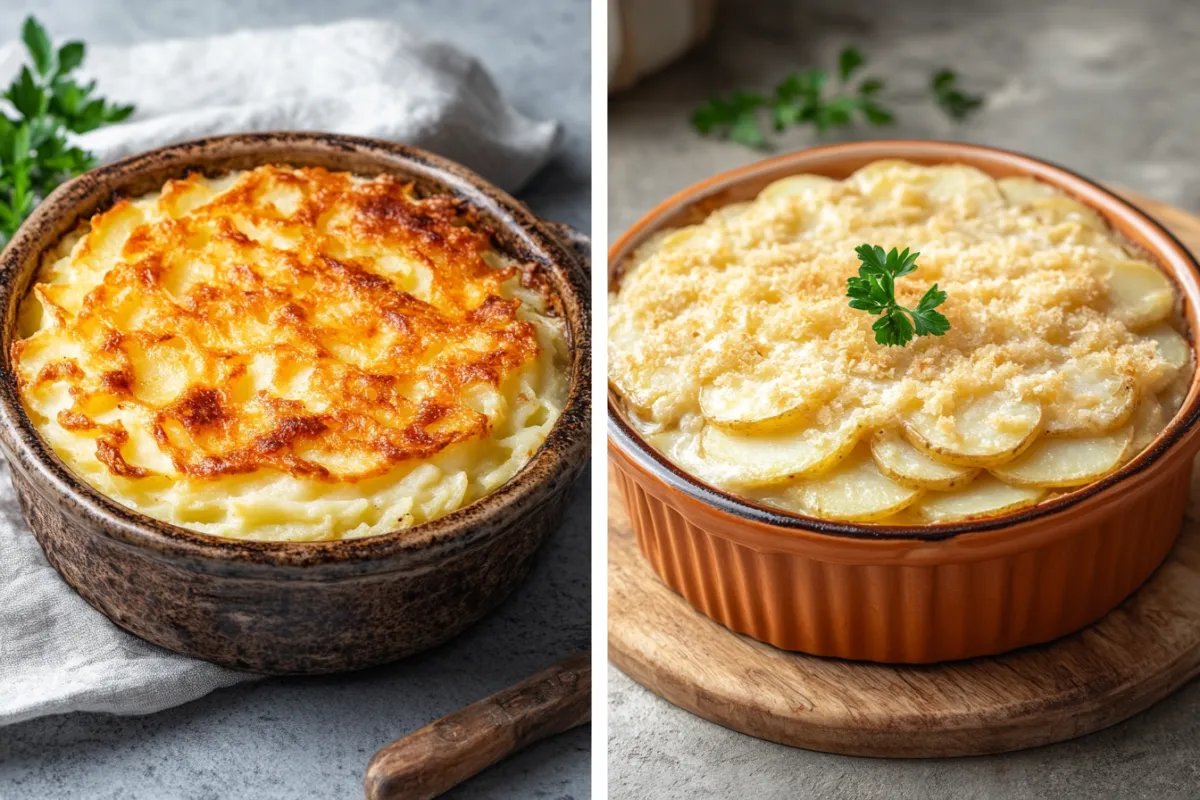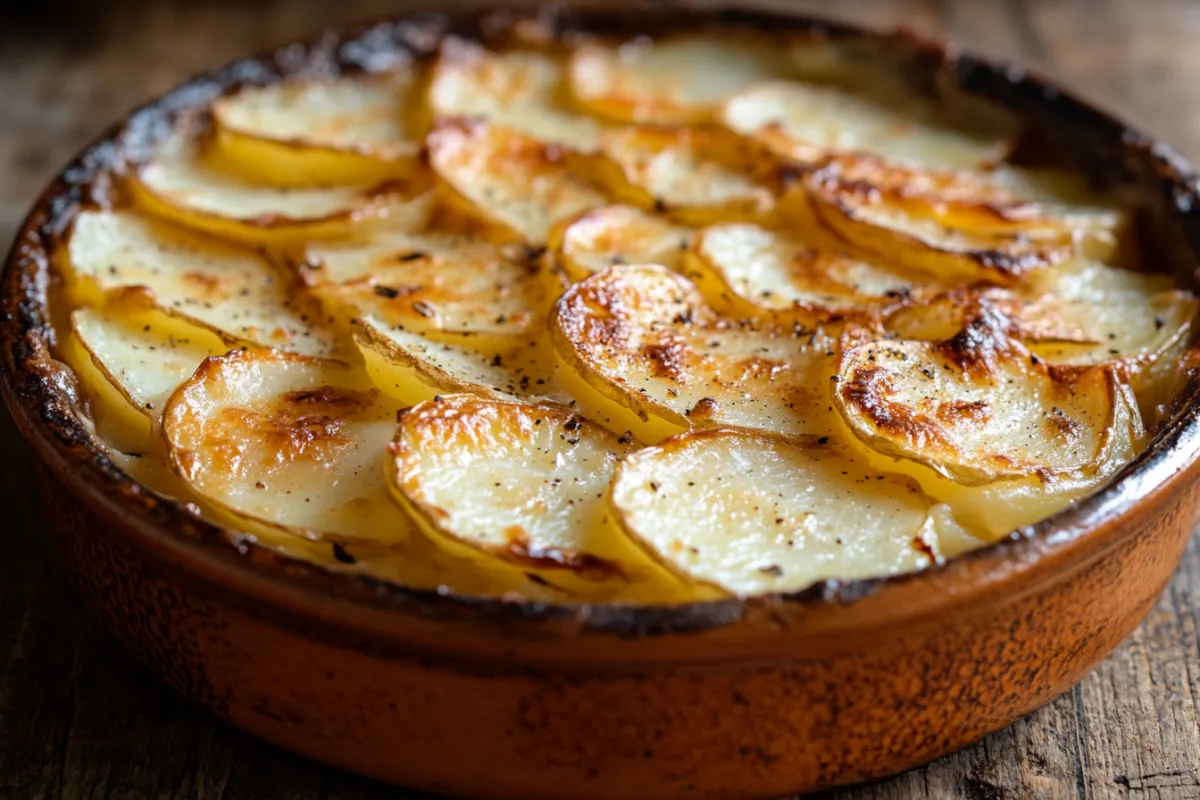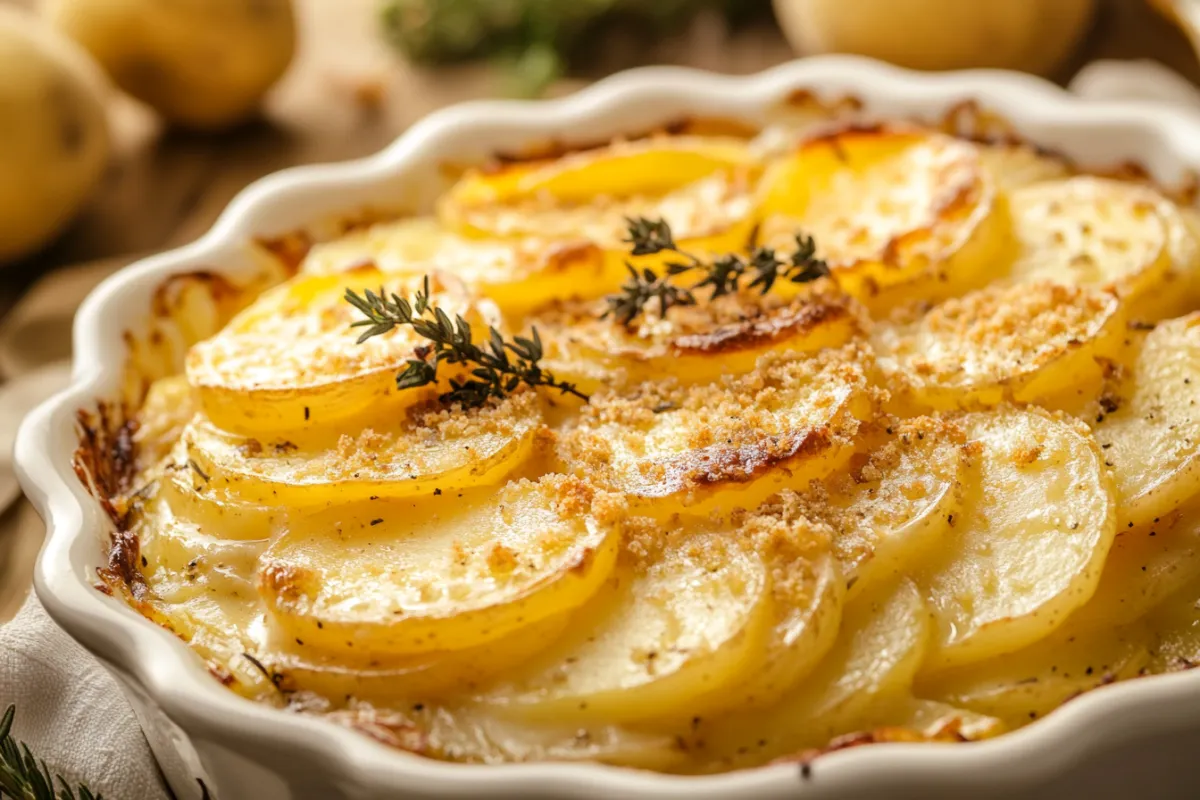Potatoes are a beloved staple worldwide, and few dishes showcase them as elegantly as dauphinoise and scalloped potatoes. These two dishes might look similar at first glance, with both featuring thinly sliced potatoes baked in a creamy sauce. However, the differences in preparation, ingredients, and texture set them apart in distinct ways. In this comprehensive guide, we’ll dive deep into what makes dauphinoise and scalloped potatoes unique, from their historical roots to modern variations, ensuring you have all the knowledge you need to make an informed choice between these two delicious dishes.
Table of Contents
- Introduction to Dauphinoise and Scalloped Potatoes
- Historical Origins
- Key Ingredients in Dauphinoise Potatoes
- Key Ingredients in Scalloped Potatoes
- Traditional Cooking Methods
- Flavor and Texture Comparison
- Nutritional and Health Considerations
- Common Variations and Regional Interpretations
- How to Choose Between Dauphinoise and Scalloped Potatoes
- Expert Tips for Perfecting These Dishes
- Serving Suggestions and Pairings
- Frequently Asked Questions (FAQs)
- Conclusion: Which Dish Should You Make?
1. Introduction to Dauphinoise and Scalloped Potatoes
At their core, both dauphinoise and scalloped potatoes are dishes that involve baking sliced potatoes in a rich, creamy sauce. Despite these similarities, these two dishes have distinct origins, preparation methods, and flavor profiles.
- Dauphinoise potatoes (also called gratin dauphinois) hail from France and are typically prepared by layering thinly sliced raw potatoes in a dish and baking them in heavy cream or milk with seasoning. Traditional dauphinoise recipes do not include cheese, although some modern versions may.
- Scalloped potatoes, often associated with American cuisine, involve pre-cooked or parboiled potatoes layered in a dish with a milk-based or béchamel sauce. Cheese is generally absent in traditional scalloped potatoes, making it a lighter dish compared to dauphinoise.
Both dishes are staples of comfort food cuisine and are served alongside a wide variety of main courses.
2. Historical Origins of the Two Dishes
The French Origins of Dauphinoise Potatoes
Dauphinoise potatoes trace their origins to the Dauphiné region in southeastern France, a mountainous area known for its hearty, rich food. In this region, where dairy products and potatoes were abundant, locals developed this dish as a way to create a creamy, comforting side.
Historically, the dish was a simple combination of potatoes, garlic, cream, and butter baked in a shallow dish. It was meant to provide sustenance during cold winters, and its rich, creamy nature made it a popular side for roasted meats and other main dishes. Today, dauphinoise potatoes remain a staple in French cuisine, often served in fine dining establishments as well as home kitchens.
The North American Roots of Scalloped Potatoes
While dauphinoise has deep French roots, scalloped potatoes are more commonly associated with North American cuisine. The dish became popular in the United States during the 19th century, where simple, hearty dishes were favored in homesteads and for family meals. The term “scalloped” refers to baking sliced food in a cream sauce, and this method was originally used for other vegetables like turnips and onions before it became synonymous with potatoes.
The use of milk instead of cream in scalloped potatoes made the dish lighter and more accessible, especially in homes where cream was not readily available. This dish quickly became a favorite for holidays, potlucks, and family gatherings due to its versatility and ease of preparation.
3. Key Ingredients in Dauphinoise Potatoes
The ingredients in dauphinoise potatoes are what set this dish apart from other potato-based casseroles. Here’s a breakdown of the key elements:
- Potatoes: The type of potato is crucial. Traditionally, waxy potatoes like Yukon Gold or Charlotte are preferred for dauphinoise because they hold their shape well and absorb the cream slowly without becoming mushy.
- Heavy Cream or Milk: The cream is what gives dauphinoise its signature richness. Some variations use a mix of cream and milk, while others stick to heavy cream only for an ultra-rich consistency.
- Garlic: Fresh garlic is often added to the cream for flavor. In some recipes, it is rubbed on the dish before the potatoes are layered in, giving the dish a subtle garlic undertone without overpowering it.
- Butter: The dish is usually baked in a buttered baking dish, and small dots of butter may be placed on top before baking to add richness.
- Seasoning: A simple combination of salt and pepper is used to enhance the natural flavors of the dish, with some recipes adding herbs like thyme or bay leaves.
- Cheese (optional): While traditional dauphinoise does not include cheese, modern versions often add Gruyère, Parmesan, or other sharp cheeses to create a golden, crispy topping.
4. Key Ingredients in Scalloped Potatoes
Scalloped potatoes, while similar in structure, rely on different ingredients for their signature flavor. Here’s what you’ll typically find in a traditional scalloped potato recipe:
- Potatoes: As with dauphinoise, Yukon Gold or Russet potatoes are often used. However, scalloped potatoes benefit from pre-cooking, so a variety of potatoes that can withstand the initial boiling process is ideal.
- Milk: Instead of heavy cream, scalloped potatoes use a milk-based sauce, which makes the dish lighter and less rich compared to dauphinoise. The milk may be thickened with a roux (butter and flour) to create a smooth, béchamel-like sauce.
- Onions: Thinly sliced onions are often layered between the potatoes to add depth of flavor and sweetness.
- Butter: Butter is used both in the sauce and to grease the baking dish.
- Breadcrumbs (optional): In some recipes, breadcrumbs are sprinkled on top of the dish to create a crisp, crunchy topping.
- Cheese (optional): Although traditional scalloped potatoes do not include cheese, some modern variations add it for extra richness.
5. Traditional Cooking Methods
How to Cook Dauphinoise Potatoes
- Prepare the Potatoes: Thinly slice raw potatoes. It’s essential that the slices are uniform to ensure even cooking.
- Infuse the Cream: In a small saucepan, heat heavy cream with garlic, salt, and pepper. You can also add herbs like thyme for additional flavor.
- Layer the Potatoes: Butter a baking dish and layer the potato slices, ensuring they are evenly distributed.
- Add the Cream: Pour the infused cream over the potatoes, making sure every slice is coated.
- Bake Slowly: Bake at a low temperature (about 300°F) for 1.5 to 2 hours. The slow cooking allows the potatoes to absorb the cream fully and become tender.
- Optional Cheese Topping: About 15 minutes before the dish is done, you can add grated Gruyère or Parmesan for a crispy, golden top layer.
How to Cook Scalloped Potatoes
- Pre-Cook the Potatoes: Unlike dauphinoise, scalloped potatoes are often pre-cooked or parboiled to ensure they don’t become too mushy when baked.
- Make the Sauce: In a saucepan, create a milk-based sauce by melting butter and whisking in flour to form a roux. Slowly add warm milk, whisking constantly until the sauce thickens.
- Layer the Potatoes: In a greased baking dish, layer the pre-cooked potato slices evenly. Add sliced onions between layers for added flavor.
- Pour the Sauce: Pour the sauce over the potatoes, making sure all the layers are well-coated.
- Bake at a Higher Temperature: Scalloped potatoes are typically baked at a higher temperature (around 350°F) for 45 minutes to 1 hour, until the sauce is bubbly and the top is golden.
6. Flavor and Texture Comparison
The Richness of Dauphinoise Potatoes
The primary flavor of dauphinoise potatoes comes from the heavy cream and garlic, which imbue the potatoes with a rich, savory taste. The slow cooking process allows the potatoes to absorb the cream, creating a velvety texture that is both soft and indulgent.
If you add cheese, the dish becomes even richer, with a slightly nutty flavor from the Gruyère or Parmesan. The cheese also provides a golden, crispy topping, which contrasts nicely with the creamy layers beneath.
The Subtlety of Scalloped Potatoes
Scalloped potatoes, on the other hand, have a lighter, subtler flavor profile. The milk-based sauce adds creaminess without overwhelming the potatoes, and the onions bring a slight sweetness to the dish.
The texture of scalloped potatoes is also more structured, thanks to the use of pre-cooked potatoes. This ensures that the potatoes retain their shape, even after baking. If you add breadcrumbs to the top, you’ll also get a pleasant crunch that contrasts with the soft interior.
7. Nutritional and Health Considerations
When considering the health aspects of these two dishes, the main difference lies in their fat content.
Dauphinoise Potatoes
- Calories: Due to the use of heavy cream, dauphinoise potatoes are higher in calories, with each serving ranging from 350-450 calories, depending on the amount of cream and cheese used.
- Fat: The dish is also high in fat, particularly saturated fat, which comes from the cream. If cheese is added, this increases the fat content further.
Scalloped Potatoes
- Calories: Scalloped potatoes are lower in calories, typically ranging from 200-300 calories per serving, depending on the type of milk used.
- Fat: The use of milk instead of cream significantly reduces the fat content. Using low-fat milk can further reduce the fat in this dish, making it a healthier option.
8. Common Variations and Regional Interpretations
Over time, both dauphinoise and scalloped potatoes have evolved, with chefs and home cooks experimenting with different flavors and textures.
Modern Dauphinoise Variations
- Cheese Toppings: Some modern versions of dauphinoise potatoes incorporate cheese like Gruyère or Comté, turning the dish into a gratin. The cheese adds a nutty flavor and a crispy top layer.
- Herbs: Herbs like thyme or rosemary are sometimes added to the cream for additional flavor.
Modern Scalloped Variations
- Cheese Additions: While traditional scalloped potatoes do not contain cheese, modern variations often include cheddar or Parmesan for a richer flavor.
- Breadcrumb Topping: To add texture, some recipes include a breadcrumb topping, which creates a crunchy contrast to the creamy potatoes.
Both dishes are highly adaptable, allowing you to incorporate seasonal herbs or experiment with different types of cheese.
9. How to Choose Between Dauphinoise and Scalloped Potatoes
When deciding between these two dishes, consider the overall richness and texture you’re aiming for in your meal. Here are some tips:
- Choose Dauphinoise Potatoes If: You want a rich, indulgent side dish with a creamy texture. This dish pairs beautifully with roasted meats, grilled vegetables, or as a luxurious holiday side.
- Choose Scalloped Potatoes If: You prefer a lighter dish that is still creamy but not as heavy as dauphinoise. Scalloped potatoes are perfect for weeknight dinners, pairing well with dishes like baked chicken or steamed fish.
10. Expert Tips for Perfecting These Dishes
Tips for Perfect Dauphinoise Potatoes
- Slice the Potatoes Thinly: For the best texture, ensure your potatoes are sliced 1/8-inch thick. This allows them to cook evenly and absorb the cream fully.
- Don’t Rush the Baking Process: Dauphinoise potatoes require slow cooking at a low temperature to achieve that melt-in-your-mouth texture. Baking them too quickly will result in undercooked potatoes or curdled cream.
- Cheese Topping: If you want a golden, crispy top layer, sprinkle cheese over the potatoes in the last 15 minutes of baking.
Tips for Perfect Scalloped Potatoes
- Pre-Cook the Potatoes: To ensure your potatoes are fully cooked without becoming mushy, boil them for about 5-7 minutes before layering them in the dish.
- Use a Roux: For a smooth, creamy sauce, create a roux with butter and flour before adding the milk. This will prevent the sauce from separating during baking.
- Experiment with Add-Ins: Try adding leeks or herbs like parsley to your scalloped potatoes for a fresh twist.
11. Serving Suggestions and Pairings
Both dauphinoise and scalloped potatoes are incredibly versatile and pair well with a variety of main dishes:
- Dauphinoise Potatoes: This rich, creamy side is best served alongside roasted meats like lamb, beef, or chicken. The luxurious texture also complements grilled vegetables and works beautifully in holiday meals.
- Scalloped Potatoes: Lighter than dauphinoise, scalloped potatoes are perfect for weeknight dinners. Pair them with baked fish, chicken breasts, or even grilled tofu for a simple, balanced meal.
If you’re looking for other vegetable-based sides, you might enjoy reading about how to keep zucchini from getting soggy when roasting, which offers tips that can also be applied to roasted potato dishes.
12. Frequently Asked Questions (FAQs)
Are Dauphinoise Potatoes the Same as Scalloped Potatoes?
No, dauphinoise potatoes are baked in cream and may contain cheese, while scalloped potatoes are typically made with a milk-based sauce and do not traditionally include cheese.
Can I Add Cheese to Scalloped Potatoes?
Yes, adding cheese to scalloped potatoes is a popular modern variation, but this technically turns them into an au gratin dish.
Which Dish Is Healthier?
Scalloped potatoes are generally healthier due to the lower fat content from the milk sauce. Dauphinoise potatoes are richer and higher in fat due to the use of cream and cheese.
Can I Make These Dishes Ahead of Time?
Yes! Both dishes can be prepared in advance and stored in the refrigerator for up to 24 hours before baking. This makes them perfect for busy meal prep or holiday gatherings.
13. Conclusion: Which Dish Should You Make?
When it comes to choosing between dauphinoise and scalloped potatoes, it all boils down to your taste preferences and the occasion. For a rich, indulgent side that will wow your guests, opt for dauphinoise potatoes. On the other hand, if you’re looking for a lighter, simpler dish to accompany a weeknight meal, scalloped potatoes are the way to go.
Both dishes have their merits, and with a little practice, you can master them to suit any occasion. Whether you’re cooking for a special holiday gathering or just a cozy family dinner, these classic potato dishes will always deliver.




